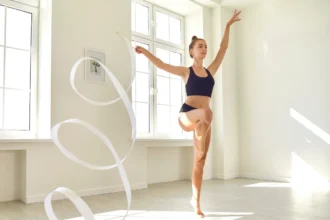Gymnastics is known for being a demanding sport that combines strength, flexibility, agility, and grace. But if you’re new to gymnastics or just curious, you might be wondering about the different levels and what it takes to reach the top. So, what exactly is the highest level in gymnastics, and how does someone get there?
Let’s take a tour of each step on the gymnastics ladder.
Overview of Gymnastics Levels
In the United States, gymnastics is structured under two main programs: the Development Program (formerly the Junior Olympic program) and Elite Gymnastics. These programs define a gymnast’s training and competitive path.
The Development Program: Levels 1–10
The Development Program consists of Levels 1–10, with increasing skill difficulty and competitive intensity.
Levels 1–3: Building the Basics
At these beginner levels, gymnasts focus on core positions, fundamental tumbling (like forward rolls and cartwheels), and introductory bar skills (such as a pullover). Many gyms do not have official competitions for these levels but may host in-house showcases to build confidence and performance skills.
Levels 4–5: First Competitive Steps
At this stage, gymnasts begin compulsory routines, meaning every athlete in these levels performs the same set routines. The standardization helps judges assess form and execution while providing gymnasts with their first real competitive experience. These levels introduce structured competition and help athletes refine their technique under pressure.
Levels 6–10: The Optional Path
Once gymnasts complete the compulsory phase, they enter the optional levels, where routines can be customized to highlight individual strengths while meeting required skill elements.
- Level 6 serves as a bridge to optional competition, with moderate difficulty restrictions.
- Level 7 introduces more advanced elements, such as back handsprings on beam and twisting vaults.
- Levels 8–9 push gymnasts further, incorporating double saltos (double flips), intricate bar transitions, and complex tumbling passes.
- Level 10 is the highest level in the Development Program. At this stage, gymnasts may be aiming for college scholarships or preparing for the transition to Elite Gymnastics.
Is Level 10 the Highest in Gymnastics?
While Level 10 is the pinnacle of the Development Program, it is not the final frontier. Gymnasts who aspire to compete on the world stage must qualify for Elite Gymnastics.
Elite Gymnastics: Reaching the Top
Elite Gymnastics represents the highest level of competition and operates separately from the Development Program. To transition from Level 10 to elite status, gymnasts must pass a stringent qualification process:
- Compulsory Testing: Gymnasts must demonstrate proficiency in fundamental skills through standardized compulsory tests.
- Elite Qualifiers: After passing compulsory tests, gymnasts must achieve a qualifying score at an elite qualifier meet to enter elite-level competitions.
Junior and Senior Elite Divisions
Elite gymnastics is divided into Junior Elite and Senior Elite categories, each with specific age requirements and competition levels.
Junior Elite (Ages 11–15)
Junior Elite gymnasts compete in high-level national and international events, developing complex routines and refining their skills in preparation for Senior Elite. Their performances push the limits of difficulty and execution as they progress toward Olympic-level skills.
Senior Elite (Ages 16+)
Senior Elite gymnasts compete in global events like the World Championships and Olympic Games. At this level, routines showcase groundbreaking skills, creativity, and precision. The open-ended scoring system encourages innovation, rewarding gymnasts who push the boundaries of difficulty and execution.
Legendary athletes such as Simone Biles, Sunisa Lee, and Nadia Comăneci have set the gold standard at this level, inspiring future generations.
The Demands of Elite Gymnastics
Achieving elite status requires extraordinary commitment, intense training, and mental resilience. Elite gymnasts train 20–30 hours per week, often starting high-performance training at a young age. They undergo rigorous conditioning, skill development, and competition preparation, balancing their athletic pursuits with education and personal growth.
College Gymnastics vs. Elite Gymnastics
Many gymnasts reach Level 10 and choose to pursue college gymnastics instead of elite competition. Collegiate gymnastics (NCAA) is highly competitive but differs from elite gymnastics in terms of skill difficulty and structure. While elite gymnasts often aim for the Olympics, NCAA gymnastics focuses more on team competitions and individual performance within the collegiate system.
Beyond Artistic Gymnastics
Gymnastics comes in many forms:
- Rhythmic Gymnastics: Known for its dance elements and apparatus like ribbon, hoop, ball, and clubs.
- Trampoline and Tumbling (T&T): High-flying flips on trampoline, power tumbling runs, and double-mini events.
- Xcel Program (Women’s Gymnastics): A more flexible, recreational-competitive mix for gymnasts who want an alternative to the high-intensity path of Levels 1–10.
So, no matter your age or skill level, there’s a gymnastics track out there that can bring a sense of achievement and plenty of fun.
Final Thoughts: Enjoying the Journey
While Elite Gymnastics represents the pinnacle of the sport, Level 10 and NCAA gymnastics provide exceptional opportunities for athletes to showcase their skills at a high level. Whether aiming for the Olympics or pursuing gymnastics as a lifelong passion, every gymnast’s journey is unique—and each level presents its own challenges and rewards.
Gymnastics is more than just competition; it’s about perseverance, discipline, and pushing the limits of human ability. No matter where a gymnast’s path leads, the sport provides a foundation of strength, confidence, and excellence that lasts a lifetime.





